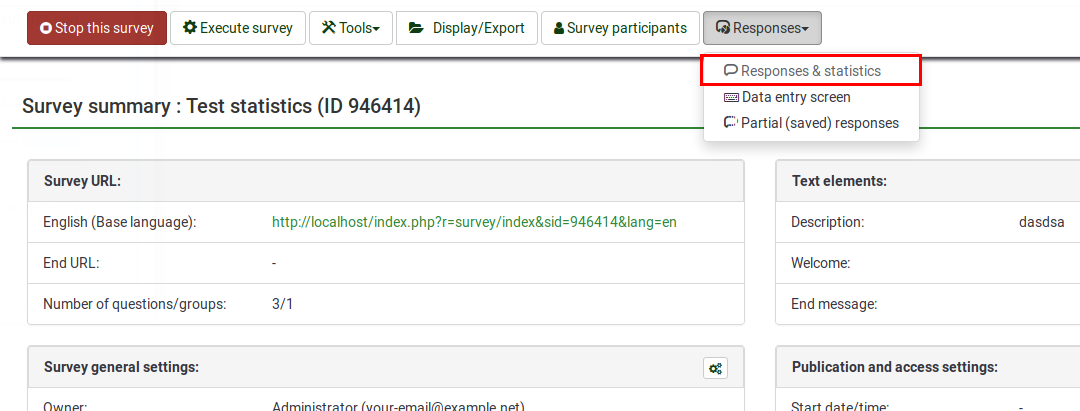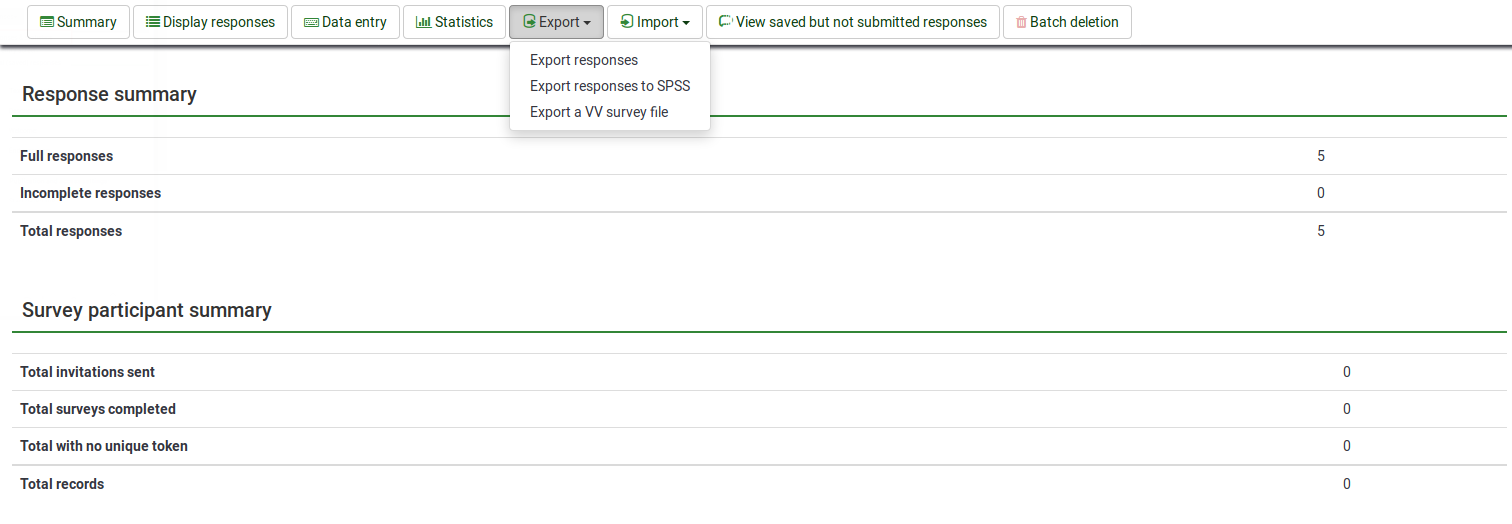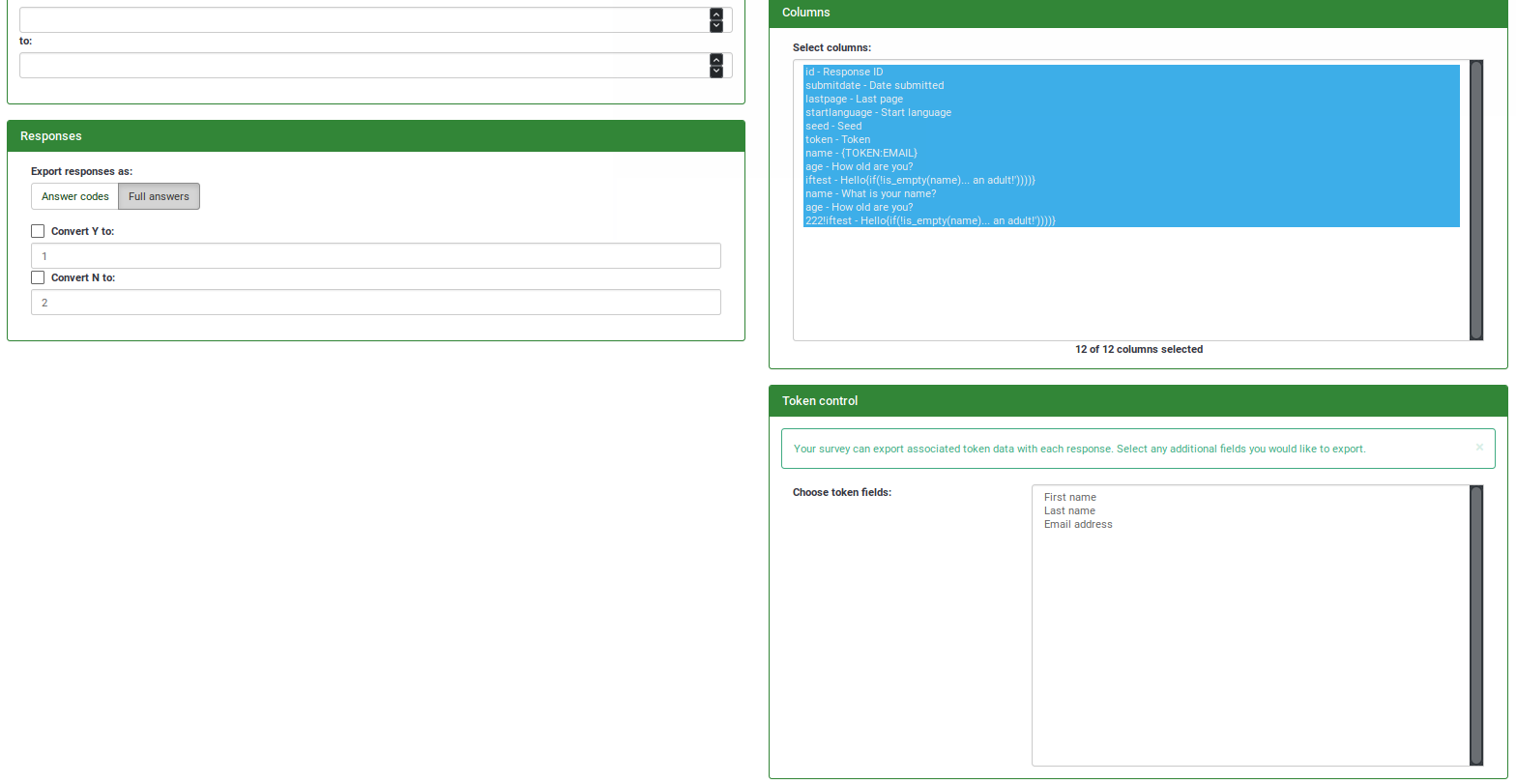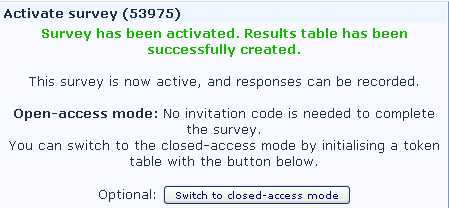Exporting results/de: Difference between revisions
From LimeSurvey Manual
(Created page with "Antwort ID Datum Abgeschickt Letzte Seite Start-Sprache Schlüsselwort Bitte bewerten Sie auf einer Skala von 1-6 (1 - vollkommen zufrieden, 6 - u...") |
(Created page with "===Neue Antworten zu den existierenden Antworten hinzufügen===") |
||
| Line 142: | Line 142: | ||
</syntaxhighlight> | </syntaxhighlight> | ||
=== | ===Neue Antworten zu den existierenden Antworten hinzufügen=== | ||
If you want to add new responses to the survey you can delete every row past row two (the both headers should not be deleted) and add the new responses using one response for each row. You can add the responses by entering them manually or copy/paste the reponses from e.g. another vv file (be carefull to add the responses only and not the header.) | If you want to add new responses to the survey you can delete every row past row two (the both headers should not be deleted) and add the new responses using one response for each row. You can add the responses by entering them manually or copy/paste the reponses from e.g. another vv file (be carefull to add the responses only and not the header.) | ||
Revision as of 10:15, 14 April 2013
Mit einem Klick auf das File:Browse.png "Ergebnisse dieser Umfrage ansehen"-Symbol kommt man in das "Antworten anzeigen"-Menü. Mit einem weiteren Klick auf das  "Ergebnisse dieser Umfrage für externe Anwendungen exportieren"-Symbol kann man die Umfrageergebnisse in eine Datei exportieren.
"Ergebnisse dieser Umfrage für externe Anwendungen exportieren"-Symbol kann man die Umfrageergebnisse in eine Datei exportieren.
Exportieren in Anwendung (Excel/.csv)
Es gibt mehrere Möglichkeiten die Daten zu exportieren, wir beginnen mit dem Export in CSV/Anwendung.
Zum exportieren von Dateien stehen folgende Optionen zur Verfügung:
- Allgemein:
Wähle einen Bereich X bis Y welche Ergebnisse exportiert werden sollen
Wähle ob alle, nur vollständige oder nur unvollständige Aufzeichnungen exportiert werden
- Fragen:
Wähle wie Überschriften aussehen sollen: Abgekürzte oder komplette Überschriften oder Fragencodes
Ersetze Leerzeichen in den Fragen durch Unterstriche
- Antworten:
Sie können entweder die ganze Frage exportieren oder die Fragencodes Y und N in eine Variable konvertieren
- Format:
Microsoft Word (Latin-Zeichensatz)
Microsoft Excel (alle Zeichensätze)
CSV File (alle Zeichensätze)
- Spalteneinstellungen:
Wähle welche Antworten exportiert werden sollen. Alle antworten in dieser Liste werden durch ihren SGQA-Identifikator repräsentiert
Wähle welche Probandendaten exportiert werden sollen. Diese Funktion ist nur verfügbar wenn die Umfrage nicht anonym ist!
SPSS Export
Allgemein
Um die Antwortdaten in SPSS zu exportieren gehen Sie zu Antworten und Statistiken und klicken sie auf das Icon um in SPSS zu exportieren.
Daten exportieren und filtern
Beim Exportieren in SPSS gibt es 2 Filteroptionen. Die können auswählen welche Daten ausgewählt werden sollen (alle/vollständige/unvollständige Aufzeichnungen) und für welche SPSS-Version die exportierten Dateien verwendet werden (vor Version 16/16 oder höher).
Der SPSS-Export beinhaltet zwei Dateien:
- eine Syntax-Datei (survey_xxxx_SPSS_syntax_file.sps)
- eine Datendatei (survey_xxxx_SPSS_data_file.dat)
Nach dem Download können Sie die Dateien mit einem einfachen Textprogramm ansehen und die exportierten Inhalte betrachten. Die Syntax-Datei beinhaltet die Kommandos die zum Importieren der Datei benötigt werden, diese sind wie eine eigene Programmiersprache für SPSS. Die Datendatei enthält alle exportierten Daten kommagetrennt. Wenn man die Daten einfach per CSV importiert gehen Daten (Information über Fragen,...) verloren, daher wird das nicht unterstützt.
Importiere Daten in SPSS
Platzieren sie die beiden Dateien in einem Ordner auf der Festplatte (Beispiel: c:\data\survey_xxxx_SPSS_syntax_file.sps und c:\data\survey_xxxx_SPSS_data_file.dat)
Jetzt gibt es zwei Optionen:
1. Wenn Sie Windows benutzen suchen sie den Ordner mithilfe des Explorers. Wen SPSS mit dem .sps Datentyp verknüpft ist reicht ein Doppelklick zum Öffnen:
Jetzt können Sie Run->All im geöffneten Fenster wählen und nach einiger Zeit sehen Sie ihren Datensatz und können ihn als .sav-Datei speichern.
2. Es kann vorkommen, dass die obige, einfache Lösung nicht funktioniert. In diesem Fall fahren sie wie folgt fort:
- Öffnen Sie SPSS
- Wählen Sie Datei->Öffnen->Syntax
- Wählen Sie die passende Datei: c:\data\survey_xxxx_SPSS_syntax_file.sps
- Die Syntax Datei wird jetzt geöffnet.
- Ändern sie die Zeile /FILE='survey_xxxx_SPSS_data_file.dat sodass sie den Pfad der Datendatei enthält: /FILE='c:\data\survey_xxxx_SPSS_data_file.dat
- Jetzt markieren Sie den ganzen Kommandotext und wählen Run->All aus dem Menü, nach einiger Zeit (bitte seien Sie geduldig) bekommen sie den Datensatz mit allen Fragen, Labels, usw.
R Export
Fügen Sie ruhig mehr Information hinzu wenn Sie welche haben!
Die Freeware R ist eine Alternative für SPSS. Der R-Export ist dem SPSS-Export sehr ähnlich in LimeSurvey.
Anweisungen zum Importieren eines Datensatzes in R:
- Laden Sie die Syntax- und die Daten- Datei herunter.
- Speichern Sie beide Dateien im R Arbeitsverzeichnis (benutzen Siegetwd() undsetwd() im R-Kommandofenster um zu setzen und anzuzeigen).
- Geben Sie source("Surveydata_syntax.R", encoding = "UTF-8") im R-Kommandofenster ein
VV-Umfrage exportieren(File:Exportvv.png) und importieren (File:Importvv.png)
Wenn sie einmal begonnen haben Antworten zu sammeln kann es vorkommen, dass Sie auf einfachem Weg größere Datenbestände ihrer Antworttabellen verändern wollen/müssen. Diese Änderungen sind meist mit einem Tabellenkalkulationsprogramm schneller und unkomplizierter zu bewerkstelligen.
Eine weitere Anwendungsmöglichkeit ist das manuelle Hinzufügen von Antworten sowie das Kopieren/Einfügen von Antworten aus anderen Tabellen (z.B. einer anderen Umfrage mit identischen Fragen/Antworten)
Bei VV-Export und Import ("VV" steht für "vertical verification") wird die Datei im .csv-Format exportiert und solange die generelle Struktur intakt bleibt, können sie alle Daten editieren und anschließend wieder importieren.
Bitte beachten Sie:
- Wenn Sie Antworten mittels "VVImport" importieren möchten wählen Sie ob alle Daten überschrieben werden sollen oder ob die neuen Daten hinzugefügt werden sollen.
- Wenn Sie Antworten aus einer anderen Umfrage mit gleichem Inhalt (z.B. gleiche Fragen/Antworten aus einer anderen Umfrage) importieren möchten, stellen Sie sicher, dass Sie die richtige VV-Datei verwenden und die ersten zwei Zeilen der CSV-Datei stimmen.
- Wenn Sie eine Umfrage in ihre LimeSurvey-Installation importieren wird sich die SID der Umfrage (wenn möglich) nicht ändern. Die Gruppen- und Fragen-IDs könnte sich jedoch ändern. Es kann so passieren dass Sie die Kopfzeilen angepasst werden muss damit die Gruppen-/Fragen-IDs wieder stimmen. Siehe hierzu "Kopfzeilen einer vv Datei anpassen".
Eine Umfrage als VV-Datei exportieren
Wenn Sie die Antworten einer Umfrage mithilfe der VV-Export-Funktion exportieren möchten klicken sie auf die "VV-Umfrage-Datei exportieren" Schaltfläche. Sie können nun angeben die Antworten welcher Umfrage exportiert werden sollen. Des Weiteren besteht die Möglichkeit anzugeben ob alle, nur komplette oder nur unvollständige Antwortsätze exportiert werden sollen. Das letzte Eingabefeld bietet die Möglichkeit eine Dateiendung für die exportierte Datei festzulegen. Der Einfachheit halber sollte .csv verwendet werden.
Nach einem Klick auf "Ergebnisse exportieren" können sie die exportierte VV-Umfrage-Datei in Microsoft Excel oder jedem anderen kompatiblen Tabellenkalkulationsprogramm öffnen und bearbeiten. Die ersten beiden Zeilen des Tabellenblattes enthalten die Spaltenüberschriften/-bezeichnungen. Die erste Zeile enthält einen für den Benutzer lesbaren Spaltenkopf mit den Details zu den Fragen- und Antwort-Feldern. Die zweite Zeile enthält die entsprechenden programminternen Spaltennamen.
Wenn sie die modifizierte Datei zu einem späteren Zeitpunkt wieder in LimeSurvey importieren möchten, sollten sie auf keinen Fall die ersten beiden Zeilen des Tabellenblattes verändern!
You should not modify the first two rows of this spreadsheet if you want to be able to "import" the data back into LimeSurvey at a later point.
Ändern einer VV-Umfrage-Datei
Die exportierte VV-Umfrage-Datei kann mit Microsoft Excel oder jedem anderen kompatiblen Tabellenkalkulationsprogramm geöffnet und bearbeitet werden. Wenn nach einem Trennzeichen für Spalten gefragt wird muss "Tabulator" angeben werden. Wenn Umlaute (wie ä, ö oder ü) in der Umfrage vorkommen empfiehlt sich zudem einen Zeichensatz wie Unicode (UTF-8) zu verwenden damit jene Umlaute korrekt angezeigt werden.
Wie bereits erwähnt dürfen die ersten beiden Zeilen der VV-Datei nicht geändert werden da es sich um die Spaltenüberschriften handelt. Je nach Anwendungsfall kann unterschieden werden ob neue Antworten zu den vorhandenen Antworten einer Umfrage hinzugefügt werden oder alle Antworten einer Umfrage überschrieben werden sollen.
As mentioned before the first two rows of the vv file are headers so you should not change them. There are different use cases for importing a vv file so we will differentiate between adding new responses to a survey and overwriting all responses of the survey.
Beispiel für den Aufbau einer VV-Datei:
Antwort ID Datum Abgeschickt Letzte Seite Start-Sprache Schlüsselwort Bitte bewerten Sie auf einer Skala von 1-6 (1 - vollkommen zufrieden, 6 - unzufrieden)
id submitdate lastpage startlanguage token 46492X40X1991
183 09.11.11 11:44 3 de 4
184 09.11.11 11:53 3 de 2
190 09.11.11 11:44 3 de 1
Neue Antworten zu den existierenden Antworten hinzufügen
If you want to add new responses to the survey you can delete every row past row two (the both headers should not be deleted) and add the new responses using one response for each row. You can add the responses by entering them manually or copy/paste the reponses from e.g. another vv file (be carefull to add the responses only and not the header.)
Example
Step 1: Open file
Response ID Date submitted Last page Start language please vote from 1 to 6 (1 - super, 6 - worst)
id submitdate lastpage startlanguage token 46492X40X1991
183 09.11.11 11:44 3 de 4
184 09.11.11 11:53 3 de 2
190 09.11.11 11:44 3 de 1
Step 2: Delete old answers
Response ID Date submitted Last page Start language please vote from 1 to 6 (1 - super, 6 - worst)
id submitdate lastpage startlanguage token 46492X40X1991
Step 3: Add new answers
Response ID Date submitted Last page Start language please vote from 1 to 6 (1 - super, 6 - worst)
id submitdate lastpage startlanguage token 46492X40X1991
17 10.11.11 12:44 3 de 4
18 24.11.11 14:53 3 de 2
You can then import the survey, make sure not to override the existing responses (see "Importing a VV survey file").
Overwriting all responses of the survey
If you want to overwrite all responses of the survey you can just add the new responses to the end of the file. As mentoind in "Adding new responses to the existing responses of a survey" you can either enter them manually or copy/paste them from another vv file.
example
Step 1: Open file
Response ID Date submitted Last page Start language please vote from 1 to 6 (1 - super, 6 - worst)
id submitdate lastpage startlanguage token 46492X40X1991
183 09.11.11 11:44 3 de 4
184 09.11.11 11:53 3 de 2
190 09.11.11 11:44 3 de 1
Step 2: Add new answers (at the end of the document)
Response ID Date submitted Last page Start language please vote from 1 to 6 (1 - super, 6 - worst)
id submitdate lastpage startlanguage token 46492X40X1991
183 09.11.11 11:44 3 de 4
184 09.11.11 11:53 3 de 2
190 09.11.11 11:44 3 de 1
17 10.11.11 12:44 3 de 4
18 24.11.11 14:53 3 de 2
You can then import the survey, make sure to override the existing responses (see "Importing a VV survey file").
Adjusting vv file headings
When importing a survey it might happen that the survey id stays the same while the group and question ids change. In order to import the survey results you have to adjust the headings of the vv file. How to import a new survey and the survey results will be explained below.
example
Step 1: Import the new survey
Step 2: Activate the new survey
Step 3: Export the "empty" results of the new survey as vv file
Step 4: Open the "empty" vv file (new SGQA: 46492X45X3269)
Response ID Date submitted Last page Start language please vote from 1 to 6 (1 - super, 6 - worst)
id submitdate lastpage startlanguage token 46492X45X3269
Step 5: Copy the first two lines/rows from the "empty" vv file
Step 6: Open the exported vv file from the old LimeSurvey installation (old SGQA: 46492X40X1991)
Response ID Date submitted Last page Start language please vote from 1 to 6 (1 - super, 6 - worst)
id submitdate lastpage startlanguage token 46492X40X1991
183 09.11.11 11:44 3 de 4
184 09.11.11 11:53 3 de 2
190 09.11.11 11:44 3 de 1
Step 7: Paste the new headings (copied two lines/rows) into the first two lines/rows of the old vv export file (now the SGQA should be 46492X45X3269)
Response ID Date submitted Last page Start language please vote from 1 to 6 (1 - super, 6 - worst)
id submitdate lastpage startlanguage token 46492X45X3269
183 09.11.11 11:44 3 de 4
184 09.11.11 11:53 3 de 2
190 09.11.11 11:44 3 de 1
You can now import the vv file and the headings are correct.
Importing a VV survey file
As long as the first two lines are intact, you can then import the data in your vv survey file back into an active LimeSurvey survey.
If you used Microsoft Excel to edit the exported vv file, the data structure of this file may be corrupted, so limesurvey is not able to import the edited file. You can try the following workaround to get the import working without an error:
- Open your exported vv file in excel and do your changes (I guess you already did that)
- Save it as tab-separated text file (It creates a new file with the extension .txt)
- Do another "clean" vv export from limesurvey
- Open this new exported vv file with a texteditor like notepad or something else (I used textwrangler on mac, it works fine with that)
- Press CTRL + A to mark all of the content and delete it
- Open the excel edited vv file (the tab separated .txt file) with a texteditor and press CTRL + A to mark all of the content
- Press CTRL + C to copy the content and paste it into the new (now empty) vv file
- Press STRG + S to save the file as it is (as .csv)
- Now try to import this file
Then, from the browse screen, choose the "Import a VV Survey file" icon.
The "Import a VV Survey File" screen needs you to choose the "vvexport" file you are importing. If you choose to "Exclude Record IDs" the records will be imported and brand new Record ID's will be generated for them (use this option for the use case "Adding new responses to the existing responses of a survey"). If you un-check this box, then the original record id's will be imported (use this option for the use case "Overwriting all responses of the survey").
There are a range of options you can choose that tell LimeSurvey how to deal with double or multiple entries.
- Report an error (and skip the new record).
- Renumber the new record
- Replace the existing record (uses this for the use case "Overwriting all responses of the survey")
Other export options
Export a single response
If you want to export an individual response, you can do it in 3 ways:
1. Login to limesurvey admin backend, choose your survey, goto "Edit survey settings" -> "Notification and data management" and make sure you receive basic email notifications.
Every time someone has completed a survey, you will receive an email with a link: "Click the following link to see the individual response"
This will take you to a page with a button above the data saying "Export this response"
2. Login to limesurvey admin backend, choose your survey and "Browse responses for this survey". Click on "Display responses" and the id number you want to export in the left column. Then you can click on "Export this survey" above the data.
3. Login to limesurvey admin backend, choose your survey and "Export results to application". In the last field above "Export data" you can choose which entry you want to export.
Match Responses From Different Surveys (longitudinal survey)
If you want to track survey responses for particular individuals over time, Limesurvey can help you do that. A possible use case is to track group responses before and after the group takes a particular seminar.
The steps to implementing this are as follows:
1. Create the survey
2. Make sure the survey is non-anonymous and uses tokens. To create a non-anonymous survey:
a) Click on the edit survey button:
b) Then under the Notification & data management tab select "No" for Anonymous answers:
3. Activate the survey.
When you activate the survey, click on the "switch to closed-access mode" button to create the token table:
4. Populate the tokens table with whatever method you wish (follow the instructions found at the Tokens page ).
5. Export the survey results and make sure you include the token information.
To export click browse results...
...and then export:
Remember to choose one or more elements from the token table to associate with the survey responses:
6. When you run the survey again, which can easily be done by copying the survey and tokens table using export/import, just repeat the steps, and make sure the same query is used to build the csv token import file.
Problems & Solutions
Excel
Modifying responses in Excel prior to Import
In order to make multiple changes to responses, you may choose to Export and open a file in Excel. Make changes to the data (other than the top lines) and then save as a .txt file. If you save as .csv, Excel uses comma-delimits which will not import into LimeSurvey. By saving as a .txt file, Excel saves as a tab-delimited file which imports back into LimeSurvey.
Edit .csv with Excel
In general we do not recommend to use Excel to edit the exported .csv files because Excel does some changes to the internal data structure which results in a failing import. If you nevertheless want to use Excel you have to set the seperator for Excel to a comma in System Control (Windows Systems):
System Control|Region- Languageoptions|Regional Settings, customize...|Tab Numbers|Digit grouping symbol| replace ; with ,
Workaround to edit .csv files with Excel
Using Excel for editing questions can prevent you from being able to re-import them. But editing is the way to go if you have more than 5 or so options or ranking options, want to use Excel capabilities like sorting, etc.
This is a partial workaround that seems to work in 1.82-essentially, only use Excel on the part of the file that is the data:
- Export a question similar to what you would like to reuse as .csv file
- Open the CSV file in a rawtext editor
- Copy the part that has the answers to Excel, and parse it with Text to Columns or equivalent.
- Use the talent of Excel to allow pasting text in columns to paste in 20, 50, 100 answers, as you wish
- Save the file as Excel CSV, which will likely have no quotes.
- Open this file in the editor, and Select All, Copy
- Go back to the file you opened in 2)
- Paste over the answers there
- Save AS, with a different name, maybe one that you can remember for reuse
- Import this file.
Excel - export limited to 255 columns
Due to limitations in Excel (versions lower and equal to 2003), LS can export only 255 columns at the same time. Microsoft has proposed a workaround as a VB macro.
Although newer spreadsheets (Excel >= 2007, OpenOffice) can display more than 255 columns, the internal module used by LimeSurvey still can't export more than 255 columns.
Two workarounds are however possible, use one of the following solutions:
- Either export to CSV and import in your spreadsheet
- Or use multiple exports (selecting at most 250 columns at a time), then merge the exported results
Excel/.csv - export fails
If you are unable to export your data to excel or into a .csv file please try to clear your browser cache and cookies.
CSV
CSV defaults to 255 columns
When exporting large surveys the GUI by default limits the export to the first 255 columns. To work around this, simpyl mark all data sets for export.
SPSS export
General steps
To import the LimeSurvey response data please use the following steps:
- Click on the 'Export to SPSS' icon.
- From the select boxes select which responses you want to export and your SPSS version.
- Download both files, the .sps (SPSS syntax command file) and .dat file (data file)
- Open the .sps file with SPSS by opening SPSS, then select 'Choose another type of file' and select the downloaded .sps file.
- Now an editor opens inside SPS where you can edit the commands in that file. Look for the line that starts with '/FILE=...'
- Edit that line and adjust the path so it points to your .dat file. Example: Your *.dat file is in c:\temp so set this line to /FILE='c:\temp\survey_(xxxx)_SPSS_data_file.dat'
- Now select all commands inside the editor by pressing CTRL-A.
- From the SPSS menu select Run/All.
- Be patient, it will take some time to import all data and labels. Check the status bar for the progress.
- Done!
Possible error messages in SPSS
ERROR. command name:Get Data
If you receive the error message ERROR. command name:Get Data. 2267 Unexpected Token missing. please edit the forth line of your syntax file so it points to the absolute path of the data file like
Error: "Text value unmappable in the current server locale"
This error can happen if you try to open an exported syntax file in SPSS 16. The solution is to force SPSS to interpret the syntax file as unicode.
LimeSurvey data can now be exported to SPSS 16 without any problem.
Define the scale to use for your variable by setting a question attribute
It is possible to override the default scale used for a variable by setting the question attribute #scale_export|scale_export to the appropriate value.
VV Export/Import
VV - Problems with vv import
If you have difficulties importing a vv file, try a Tab-delimited file and it should work fine.
Other problems and solutions
Copying responses into a different survey (using tokens)
- Create new survey, add a dummy response, export the response file, open in Excel. This creates the format for the new import file.
- Export the responses from the old survey, including tokens, open in Excel.
- Use this data to create an Excel worksheet for the standard token file import (eg. Firstname, Lastname, Token, Email address, Email status (OK), Language (En). Save as .csv and import tokens to the new survey in LimeSurvey.
- In Excel, copy the response fields from the old survey responses that you want in the new survey (including token) into the appropriate Excel column of the new survey format.
- Save as .txt file.
- Use VVImport to import the new data into the new survey.
- Possible import errors include date format - some system date fields do not allow a NULL value, some do. If the date looks okay but gives an error, use the Excel cell format "2009-12-01!







